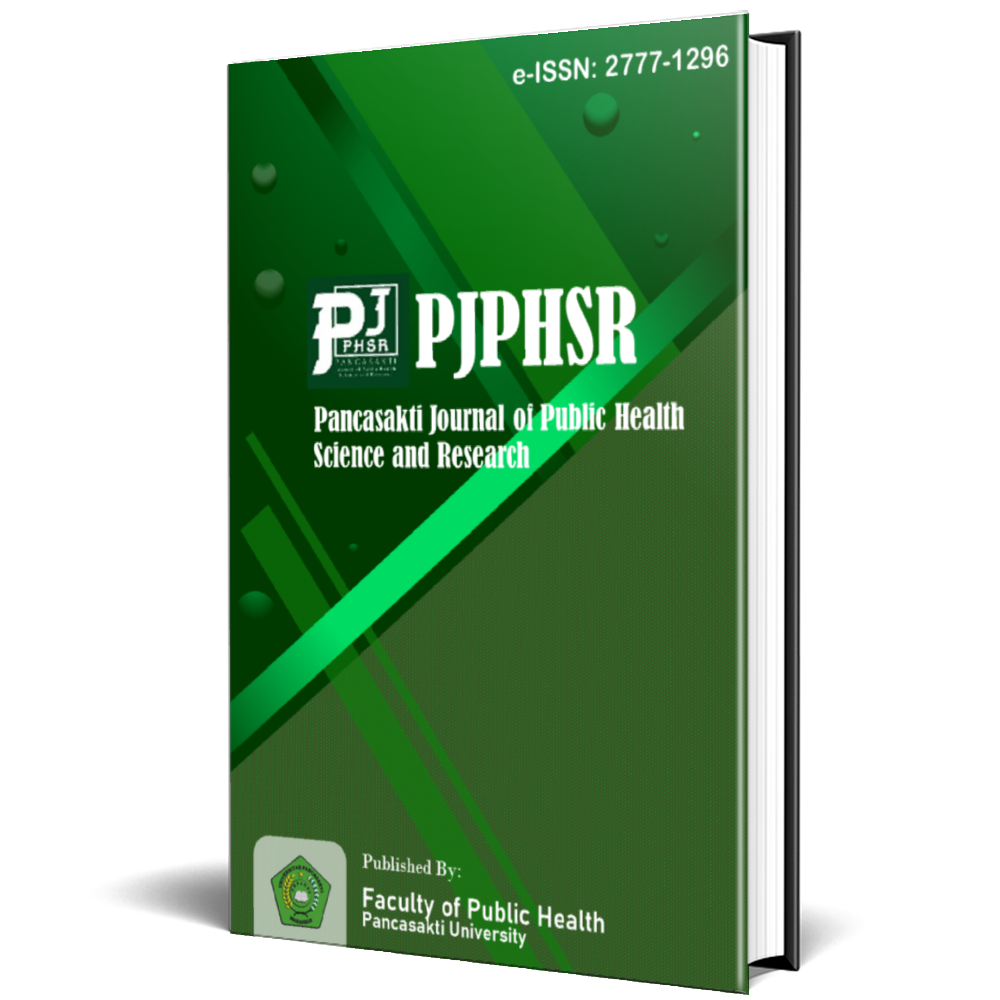Prevalence and Risk of Nutritional Problems among Toddlers in Balikpapan, Indonesia: A Cross-sectional Study
Abstract
Nutritional challenges during early childhood remain a pressing global concern that significantly influence a country’s Human Development Index. This study aimed to assess the prevalence and risk of undernutrition-related health problems among toddlers in Balikpapan City, East Kalimantan Province. Using a descriptive-analytic design with a cross-sectional approach, data were collected from four integrated community health post (Posyandu) located across three sub-districts. The study population comprised toddlers attending Posyandu in West Balikpapan, Central Balikpapan, and South Balikpapan. A purposive sampling technique was applied based on predefined criteria, yielding a sample size of 78 toddlers. Findings revealed that from 78 toddlers, 11,5% toddlers were at risk of malnutrition, 20,5% toddlers were at risk of undernutrition, and 2,6% toddlers were at risk of stunting. These findings highlight the urgent need for targeted preventive interventions to address undernutrition risks in early childhood and offer valuable evidence to support regional health policy development. Prenatal interventions, including maternal supplementation and antenatal care are crucial. Exclusive breastfeeding remains essential but should be supported by broader strategies addressing complementary feeding and maternal conditions. Longitudinal studies are recommended to establish causal pathways.
References
Jana, A., Dey, D. & Ghosh, R. Contribution of low birth weight to childhood undernutrition in India: evidence from the national family health survey 2019–2021. BMC Public Health 23, 1336 (2023). https://doi.org/10.1186/s12889-023-16160-2
Kementerian Kesehatan RI (2023). Angka Stunting tahun 2022 turun menjadi 21,6 persen [online] available from https://www.badankebijakan.kemkes.go.id/angka-stunting-tahun-2022-turun-menjadi-216-persen/
Mardani, R. A. D., Wu, W. R., Nhi, V. T., & Huang, H. C. (2022). Association of breastfeeding with undernutrition among children under 5 years of age in developing countries: A systematic review and meta-analysis. Journal of nursing scholarship: an official publication of Sigma Theta Tau International Honor Society of Nursing, 54(6), 692–703. https://doi.org/10.1111/jnu.12799
Mustakim, M. R. D., Irwanto, Irawan, R., Irmawati, M., & Setyoboedi, B. (2022). Impact of Stunting on Development of Children between 1-3 Years of Age. Ethiopian journal of health sciences, 32(3), 569–578. https://doi.org/10.4314/ejhs.v32i3.13
Nashiri, M. F., & Lukman, A. I. (2024). Upaya Pemerintah dalam Mengatasi Stunting di Kelurahan Karang Rejo Kota Balikpapan. eJournal Pembangunan Sosial, 12 (2): 168-179. Available from http://ejournal.ps.fisip-unmul.ac.id/site/wp-content/uploads/2024/06/Upaya%20Pemerintah%20Mengatasi%20Stunting%20di%20Kelurahan%20Karang%20Rejo%20(Fahran)%20(06-27-24-01-40-46).pdf
Radaelli, G., Leal-Conceição, E., Kalil Neto, F., Taurisano, M. R. G., Majolo, F., Bruzzo, F. T. K., Booij, L., & Nunes, M. L.. (2023). Motor and cognitive outcomes of neonates with low birth weight in Brazil: a systematic review and meta-analysis. Arquivos De Neuro-psiquiatria, 81(2), 186–200. https://doi.org/10.1055/s-0042-1758866
Titaley CR, Ariawan I, Hapsari D, Muasyaroh A, Dibley MJ. Determinants of the Stunting of Children Under Two Years Old in Indonesia: A Multilevel Analysis of the 2013 Indonesia Basic Health Survey. Nutrients. 2019 May 18;11(5):1106. https://doi.org/10.3390%2Fnu11051106
UNICEF (2023). UNICEF-WHO-The World Bank: Joint Child Malnutrition Estimates (JME) – Levels and Trends – 2023 edition. Available from https://data.unicef.org/resources/jme-report-2023/
UNICEF (2024). Nutrition. [online] Available from https://www.unicef.org/nutrition
Upadhyay, R.P., Naik, G., Choudhary, T.S. et al. Cognitive and motor outcomes in children born low birth weight: a systematic review and meta-analysis of studies from South Asia. BMC Pediatr 19, 35 (2019). https://doi.org/10.1186/s12887-019-1408-8
Vats, H., Walia, G. K., Saxena, R., Sachdeva, M. P., & Gupta, V. (2024). Association of Low Birth Weight with the Risk of Childhood Stunting in Low- and Middle-Income Countries: A Systematic Review and Meta-Analysis. Neonatology, 121(2), 244–257. https://doi.org/10.1159/000532006
Victora, C. G., Christian, P., Vidaletti, L. P., Gatica-Domínguez, G., Menon, P., Black, R. E. (2021). Revisiting maternal and child undernutrition in low-income and middle-income countries: variable progress towards an unfinished agenda. The Lancet, Volume 397, Issue 10282, Pages 1388-1399, ISSN 0140-6736. https://doi.org/10.1016/S0140-6736(21)00394-9
WHO (2024). Malnutrition. [online] Available from https://www.who.int/news-room/fact-sheets/detail/malnutrition
Wijiwinarsih, A., Susilawati, T. N., & Murti, B. (2019). The Effect of Exclusive Breastfeeding on Wasting in Children Under Five: A Meta-Analysis Study. Journal of Maternal and Child Health, 4(2), 87–96. Retrieved from https://thejmch.com/index.php/thejmch/article/view/169
Copyright (c) 2025 Tanti Asrianti, Siswanto Siswanto, Irfansyah Baharuddin Pakki, Khumairotul Zahroh Al Ahmadi, Akhmad Dzikri

This work is licensed under a Creative Commons Attribution-NonCommercial-ShareAlike 4.0 International License.








